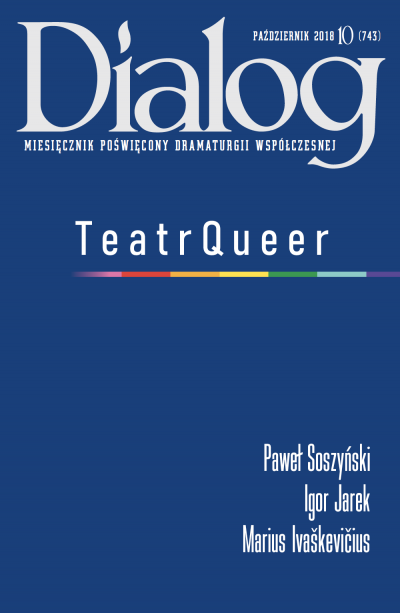Plays
Teo
Paweł Soszyński
A camp fantasy, presented on stage by a group of elderly homosexuals, wandering through the fairy tale Land of Oz in their imagination. The characters have got their historical origin: they are “pink triangle” men, who were placed in concentration camps because of their orientation or suffered other traumatic losses during the war. And yet, in their memories the terrible years of their youth are at the same time beautiful, mythologized, and full of eroticism. The action takes place on several levels, and as a whole it constitutes a drag concert.
Queen
Igor Jarek
A monoplay. A boy from the dregs of society talks about his adventures. When he leaves the orphanage and gets a job as a bodyguard in the shop, he quickly gets into a fight, and then the “Queen”, a mysterious, much older woman, stands up for him. Thanks to her, the main character changes his life and finally is happy, but he does not know who he has really got involved with. The advantage of the text are a well mimicked jargon of the street, the mood full of lyricism and humour, and a surprising, captivating action.
Close City (Artimas miestas)
Marius Ivaškevičius
The inspiration for the play was a real story: a decent housewife from Malmo was found dead in the red-light district of Copenhagen, connected with Malmo by a bridge. This story forms the main axis of the text: Anika and her husband Iwo, an ordinary young couple tired of the everyday routine of a small town, free their demons in another city, which is of almost sacred importance to them. But there is also a second story, less real, full of oneiric cruelty, like a reflection of unspoken imaginations of the main characters.
Essays, Studies
Idiotic theatre. The beginnings
Joanna Krakowska
Inspirations and beginnings of the Ridiculous theatre in New York and its anarchist poetics. What was the Ridiculous style and how many theatres were operating under that name? John Vaccaro’s Play-House of the Ridiculous and Charles Ludlam’s Ridiculous Theatrical Company operated separately from 1967, but both remained valid both for the American avant-garde and for the emancipation movement of homosexual people. And the poetics of idiocy became real in politics.
The Queer Root of Theatre
Laurence Senelick
An essay from the book The Queerest Art. Essays on Lesbian and Gay Theatre, edited by Alisa Solomon and Framji Minwalla, New York University Press, New York-London 2002.
“Be True to Yearning”. Note on the Pioneers of Queer Theatre
Don Shewey
An essay from the book The Queerest Art. Essays on Lesbian and Gay Theatre, edited by Alisa Solomon and Framji Minwalla, New York University Press, New York-London 2002.
Queer Feelings
Sara Ahmed
A chapter from Sara Ahmed's book The Cultural Politics of Emotion, Edinburgh University Press 2004.
Types of Acts
Esther Newton
A chapter from Esther Newton's book Mother Camp: Female Impersonators in America, The University of Chicago Press, Chicago and London 1972.
We are not in Kansas, or gay people explain the world to us
Joanna Krakowska
The gay mythology of the Wizard of Oz is much more than common beliefs about the relationship of the rainbow flag with the Somewhere Over the Rainbow ballad, or the cult of Judy Garland and the riots at the Stonewall bar. Dee Michel wrote a book Friends of Dorothy: Why Gay Boys and Gay Men Love the Wizard of Oz (Dark Ink Press 2018), in which, based on his own research, he answered the question posed in the title of the book.
Another politics is possible
Piotr Morawski
In order to gain new allies in theatre, you have to tell the story with great effect. In this respect, King, based on the novel by Szczepan Twardoch, staged by Monika Strzępka at the Polski Theatre in Warsaw, is an ideal performance. However, can showing an upside-down world on stage and awakening fantasies about violence, bring something good? Even if these are the moods of the anti-fascist street and the King skilfully grasps them?
Nordic noir. How to see Scandinavia?
Monika Rawska
International popularity of crime novels by Scandinavian authors has led to the establishment of a generic name for this specific variety: Nordic noir. And although it is a broad term, naturalism and social realism, bleak locations and moody detectives stand out as key elements.
Columns
Marek Beylin, Tadeusz Nyczek, Pedro Pereira
Varia
Notes on plays: Michael Hastings Tom and Viv; Maria Maier Könige; Natasha Gordon Nine Nighti, Maria Gantzowa (1926-2018) – farewell. Playbill.



